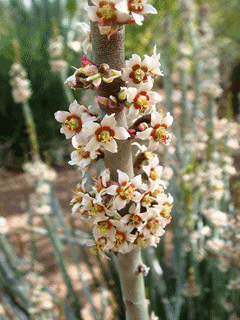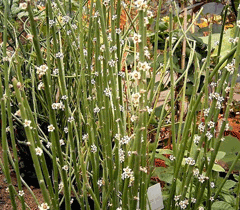 |
|
http://commons.wikimedia.org/wiki/User:Miwasatoshi |
 |
| http://commons.wikimedia.org/wiki/User:Ies |
Translate this page:
Summary
Euphorbia cerifera Alcocer is a synonym of Euphorbia antisyphilitica Zucc.
Physical Characteristics

 Euphorbia_antisyphilitica is an evergreen Shrub growing to 1 m (3ft 3in).
Euphorbia_antisyphilitica is an evergreen Shrub growing to 1 m (3ft 3in).
See above for USDA hardiness. It is hardy to UK zone 8. It is in leaf all year. The species is monoecious (individual flowers are either male or female, but both sexes can be found on the same plant) and is pollinated by Insects.
Suitable for: light (sandy) and medium (loamy) soils and prefers well-drained soil. Suitable pH: mildly acid, neutral and basic (mildly alkaline) soils. It cannot grow in the shade. It prefers dry or moist soil and can tolerate drought.
UK Hardiness Map
US Hardiness Map
Synonyms
Euphorbia cerifera Alcocer
Plant Habitats
Edible Uses
A wax from the plant can be used to make chewing gum[46, 61].
References More on Edible Uses
Medicinal Uses
Plants For A Future can not take any responsibility for any adverse effects from the use of plants. Always seek advice from a professional before using a plant medicinally.
None known
References More on Medicinal Uses
The Bookshop: Edible Plant Books
Our Latest books on Perennial Plants For Food Forests and Permaculture Gardens in paperback or digital formats.

Edible Tropical Plants
Food Forest Plants for Hotter Conditions: 250+ Plants For Tropical Food Forests & Permaculture Gardens.
More

Edible Temperate Plants
Plants for Your Food Forest: 500 Plants for Temperate Food Forests & Permaculture Gardens.
More

More Books
PFAF have eight books available in paperback and digital formats. Browse the shop for more information.
Shop Now
Other Uses
A wax is obtained from the whole plant and is used as a polish, water proofer, for making records, lighting etc[21, 46, 57, 61]. The wax exudes from the plant pores and forms a thin skin on the stems. Most is produced in the winter and it is extracted by boiling up the plant[171]. Carbon Farming - Industrial Crop: wax. Dynamic accumulator.
Special Uses
References More on Other Uses
Cultivation details
Prefers a light well-drained moderately rich loam in an open position[200]. Requires ample water in the growing season but very dry conditions in the winter[1]. We are not sure if his plant can be grown outdoors in Britain[K], one report says that this plant is hardy to zone 8 (which experiences temperatures down to -5°c)[200]. Another report says that minimum winter temperatures of 8 - 10°c are ample for the plant to survive[1]. Hybridizes with other members of this genus[200]. The ripe seed is released explosively from the seed capsules[200]. Members of this genus are rarely if ever troubled by browsing deer and rabbits[233]. This genus has been singled out as a potential source of latex (for making rubber) for the temperate zone, although no individual species has been singled out[141].
References Carbon Farming Information and Carbon Sequestration Information
Temperature Converter
Type a value in the Celsius field to convert the value to Fahrenheit:
Fahrenheit:
The PFAF Bookshop
Plants For A Future have a number of books available in paperback and digital form. Book titles include Edible Plants, Edible Perennials, Edible Trees,Edible Shrubs, Woodland Gardening, and Temperate Food Forest Plants. Our new book is Food Forest Plants For Hotter Conditions (Tropical and Sub-Tropical).
Shop Now
Plant Propagation
Seed - sow spring in a warm greenhouse. When they are large enough to handle, prick the seedlings out into individual pots and grow them on in the greenhouse for at least their first winter. Plant them out into their permanent positions in late spring or early summer, after the last expected frosts. Cuttings can be taken throughout the growing season. Leave them to dry and callus for 2 weeks before potting them up[1].
Other Names
If available other names are mentioned here
Native Range
NORTHERN AMERICA: United States (New Mexico (south), Texas), Mexico (Chihuahua, Coahuila de Zaragoza, Hidalgo, Querétaro)
Weed Potential
Right plant wrong place. We are currently updating this section.
Please note that a plant may be invasive in one area but may not in your area so it’s worth checking.
None Known
Conservation Status
IUCN Red List of Threatened Plants Status : This taxon has not yet been assessed

Growth: S = slow M = medium F = fast. Soil: L = light (sandy) M = medium H = heavy (clay). pH: A = acid N = neutral B = basic (alkaline). Shade: F = full shade S = semi-shade N = no shade. Moisture: D = dry M = Moist We = wet Wa = water.
Expert comment
Author
Zucc.
Botanical References
200
Links / References
For a list of references used on this page please go here
Readers comment